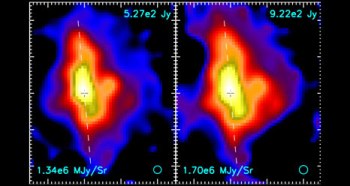Apr 17 2013
Researchers using the airborne Stratospheric Observatory for Infrared Astronomy (SOFIA) have captured the most detailed mid-infrared images yet of a massive star condensing within a dense cocoon of dust and gas.
 Figures 1a and 1b show the G35 protostar at wavelengths of 31 and 37 microns taken by the FORCAST instrument on the SOFIA observatory's infrared telescope in 2011. (Zhang et al. 2013, Astrophysical Journal)
Figures 1a and 1b show the G35 protostar at wavelengths of 31 and 37 microns taken by the FORCAST instrument on the SOFIA observatory's infrared telescope in 2011. (Zhang et al. 2013, Astrophysical Journal)
The star is G35.20-0.74, commonly known as G35. It is one of the most massive known protostars and is located relatively close to Earth at a distance of 8,000 light-years.
Until now, scientists expected the formation process of massive stars would be complicated by the turbulent, chaotic environments in the centers of new star clusters where they form. But observations of G35 suggest this giant star, more than 20 times the mass of our sun, is forming by the same orderly process as do stars with the same mass as the sun. Stars most like the sun are understood to form by simple, symmetric collapse of interstellar clouds.
"The focus of our study has been to determine how massive stars actually form," said Yichen Zhang of the University of Florida. Zhang is lead author of a paper about the discovery published April 10 in the Astrophysical Journal. "We thought the G35 protostar's structure would be quite complicated, but instead we found it is simple, like the cocoons of protostars with the sun's mass."
The observations of G35 were made in 2011 with a special camera aboard SOFIA, a modified Boeing 747SP aircraft that can carry a telescope with an effective diameter of 100 inches (2.5 meters) to altitudes as high as 45,000 feet (13,700 meters).
G35 was an ideal target for investigations because it is in an early stage of development. But infrared light coming from G35 is so strong it prevented infrared space telescopes from making detailed images. Also, the protostar is embedded so deeply in its natal cloud that it cannot be detected by optical telescopes observing from the ground at visible wavelengths.
Flying high above the light-blocking water vapor in Earth's atmosphere, the airplane-mounted Faint Object Infrared Camera for the SOFIA Telescope (FORCAST) enabled astronomers to see G35 where it hides -- inside a dark, dense, interstellar dust cloud -- by collecting infrared light escaping the cloud. Uniquely suited for this work, FORCAST detected faint details next to bright structures at wavelengths inaccessible to any other telescope on the ground or in space.
"Massive stars, although rare, are important because there is evidence they foster the formation of smaller stars like our sun, and because at the ends of their lives they create and distribute chemical elements that are the basic building blocks of Earth-like planets," said co-author James De Buizer , a SOFIA staff scientist with the Universities Space Research Association (USRA) at NASA's Ames Research Center in Moffett Field, Calif.
Figures 1a and 1b show FORCAST images of G35 at wavelengths of 31 and 37 microns. Figures 2a and 2b respectively present G35 images obtained by NASA's Spitzer Space Telescope and the Gemini-North telescope at Mauna Kea, Hawaii, also used in this study. Figure 3 shows computer model images intended to match characteristics of the central regions of the images in figures 1a and 1b.
The model images show greatly simplified versions of what is revealed especially in the SOFIA images: a luminous protostar heating a dense interstellar cloud from the inside while simultaneously expelling cone-shaped jets of gas toward the tops and bottoms of the frames. The top outflow cone appears brighter because it is directed toward us and there is less obscuring material along the line of sight.
The high resolution of the images showcases the capability of modern infrared detector arrays when used on an airborne platform and gives scientists hope that data gathered in this way substantially will advance their understanding of the Milky Way galaxy.
FORCAST was built by a team led by Terry Herter of Cornell University in Ithaca, N.Y. Co-authors of the Astrophysics Journal paper include scientists from the University of Florida in Gainesville; University of Wisconsin in Madison; University of California at Berkeley; Louisiana State University in Baton Rouge; the Arcetri Observatory in Florence, Italy; and the USRA SOFIA science staff at Ames.
SOFIA is a joint project of NASA and the German Aerospace Center. SOFIA is based and managed at NASA's Dryden Aircraft Operations Facility in Palmdale, Calif. NASA's Ames Research Center in Moffett Field, Calif., manages the SOFIA science and mission operations in cooperation with the Universities Space Research Association (USRA) headquartered in Columbia, Md., and the German SOFIA Institute at the University of Stuttgart.
For links to USRA and the German SOFIA Institute, visit NASA's SOFIA site and click on "SOFIA Science Center."